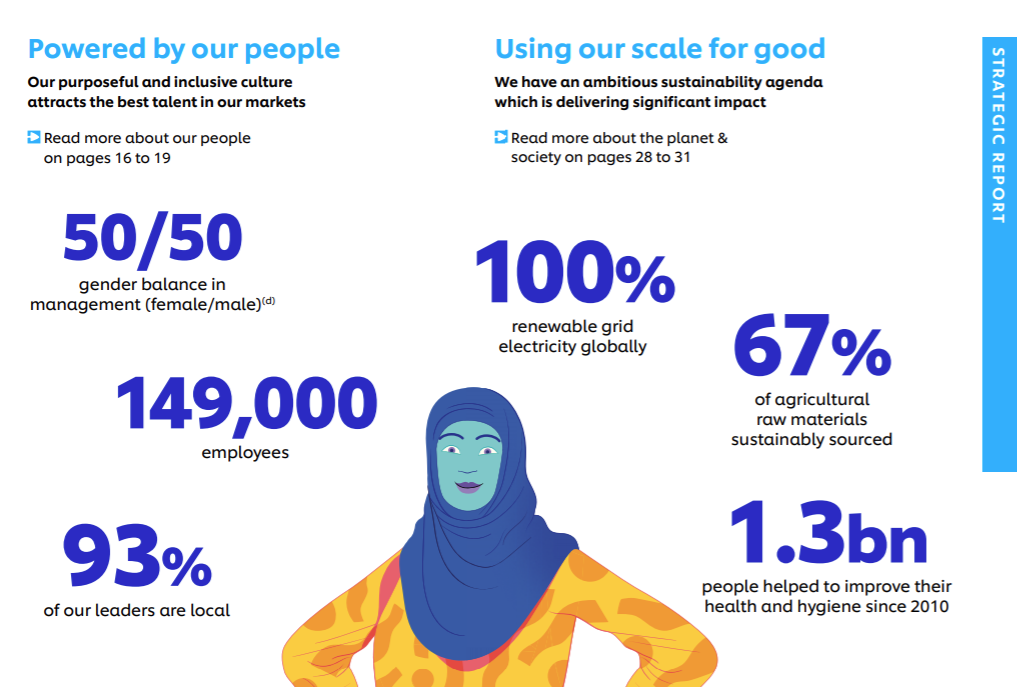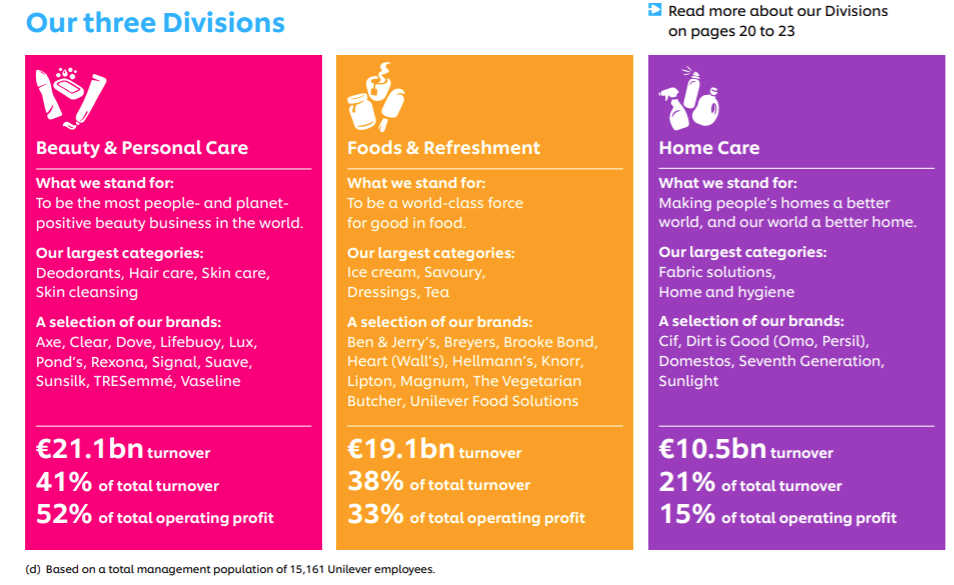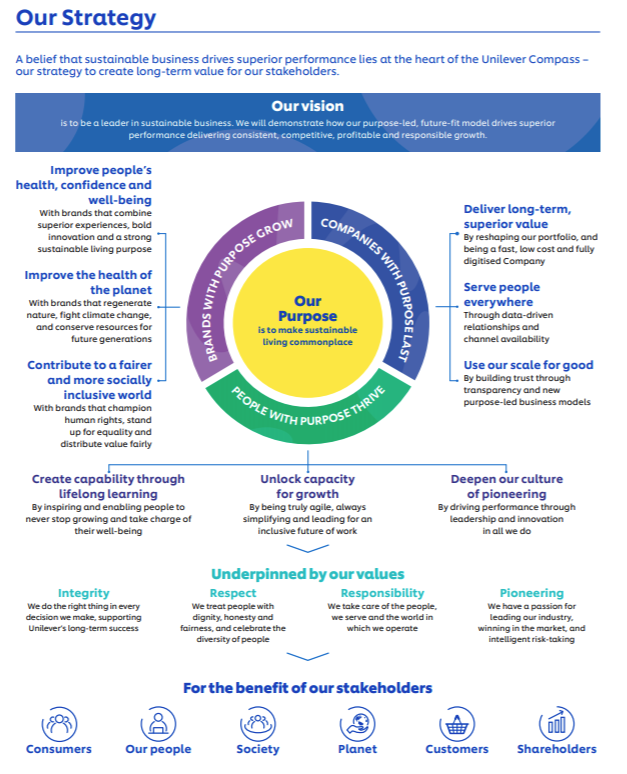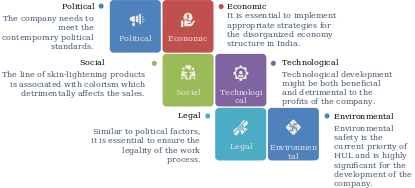Executive Summary
Unilever is a multinational company that has implemented a large number of changes and innovative policies in an attempt to stay on top of the competition. It has added a new vision and mission to its objectives concerning sustainable development and social equality resulting in a more positive relationship with the customers. The subsidiary of the company, Hindustan Unilever Limited, is the major corporation in India focusing on house products, food, and, particularly, cosmetics. The PESTLE and SWOT analyses demonstrate the current challenges and areas for the development of both Unilever and Hindustan Unilever Limited. At present, there are several obstacles to the sustainable development of the corporation specifically concerning the social tension around its cosmetic brands. Glow & Lovely has particularly encountered a large quantity of criticism and is in urgent need of an innovative approach to a line of skin-lightening products. Nevertheless, having acknowledged the strengths, weaknesses, and potential areas for improvement, it is possible to propose an effective management plan.
Introduction
Unilever is a consumer goods company based in London which sells its products globally. The market share is international, with a customer base in nearly 200 countries. However, it is not the most prominent consumer good packager due to the stiff competition in the industry. New entries to the market are intensifying the levels of competition within the industry alongside other established brands such as L’Oréal, and Proctor & Gamble (Cheng, 2021). It is the second-largest company in its specialty, packaged consumer goods, after Proctor & Gamble (Cheng, 2021). The company is based in London; however, its consumer base is global.
At the present time, Unilever has a large number of subsidiaries in various regions of the world. One of the prominent ones is Hindustan Unilever Limited (HUL) which is also specialized in consumer goods and operates in India. ‘Beauty & Personal Care’ is the most profitable category of the products provided by Unilever and is accountable for more than half of the total operating profit (Annual report 2020). The scope of the paper covers the line of skin-lightening products of the brand Glow & Lovely (Fair & Lovely previously) which is operated by Hindustan Unilever Limited. While both Unilever and its subsidiary in India are highly prominent and successful companies, it is possible to evaluate their performance and suggest hypothetical improvements concerning marketing. Therefore, the primary purpose of the paper is to critically analyze the current marketing strategies of Glow & Lovely in regard to HUL and Unilever and to propose a new product and respective business recommendations.
Branding Effectiveness
The equity of its subsections represents Unilever’s trademark. A positive client’s view of the company leads to more profits due to the more remarkable brand sameness. The company continually evaluates these factors to achieve a balance in the highly competitive market. Some of the components of the assessment include brand awareness and association. Sustainable development concerning economic, environmental, and social factors is another essential program in the framework of Unilever. The strategic report provides the following data in regard to sustainability:

The environment and social-friendly development have allowed the company to promote organic products and achieve a higher level of revenue growth:

The Indian subsidiary has also adopted the sustainable course of the main office and is accountable for more than $5.7 billion of revenue in 2020 (Hindustan Unilever Limited, 2020). The firm has grown extensively over the past two decades, assisted by digital marketing strategies. Over this period, it has enhanced its branding mechanisms to overcome completion and remain among the top companies in the same industry. The brand is recognized in different countries, including developing states.
Situational Analysis
PESTLE Analysis
The PESTLE analysis focuses on the external environment of the corporation. It is a form of macroevolution in which inquiry is founded on Unilever’s political, economic, social, technological, environmental, and legal considerations. PESTLE provides the context on which the business is based and coverage of the areas that directly or indirectly affect the company. Generally, changes in the context frequently affect the industry as a whole (Cheng, 2021). Accordingly, an advantage gained from such a transition cannot directly transform into a competitive advantage. Instead, it benefits all the firms within that particular economy. The current segment of the paper attempts to analyze the skin-lightening products of the Glow & Lovely brand and the Unilever policies in the scope of the PESTLE analysis.
Political and Legal Analysis
Unilever has a global market share, which results in subjecting its commerce to the laws, politics, and regulations of each country it operates. The corporation has developed a tactical response to issues arising from politics and law. It seeks to adhere to all the rules and emergent ones, such as that brought by the coronavirus pandemic’s effect. (Pandey et al., 2021). Furthermore, all the subsidiaries of Unilever had to upgrade their security measures in order to mitigate the risks of political instability (Unilever, 2020). Ultimately, any strife engagement, either legally or politically, is likely to impact the company negatively. Moreover, any changes in the trade policies can have a detrimental impact on the firm’s potential profits.
Economic Factors
Unilever’s success depends on the global economic situation since its performance is tied to the macro environment, which varies based on such parameters as opportunities and threats. In a number of national economies, rivalry is rising due to the availability of cheap and quality products (Zhang and Fan, 2020). India is an excellent example of a developing country with a predicted growth of the economy (Raj and Aithal, 2018). Therefore, with proper marketing and business strategies, Hindustan Unilever Limited can expect a rapid rise in its revenue growth. Nevertheless, the Indian financial region is disorganized and is associated with a hidden economy (Raj and Aithal, 2018). Thus, it is essential to comprehensively evaluate the economic factors of the region to propose effective marketing strategies in India.
Social and Environmental Factors
Social and environmental factors are of primary concern in Unilever’s recent policies and are accountable for the major changes in the Glow & Lovely brand. Sustainable development is considered to be one of the most influential trends in the contemporary economy with the rising attention to organic products and social equality. The primary line of goods in the Glow & Lovely brand is skin-whitening products which have encountered a large amount of criticism in recent years. This type of cosmetic is frequently associated with colorism which is an implication that white skin color is aesthetically superior to darker tones (Adbi et al. 2021). This belief is historically established in most Asian countries due to cultural traditions and stigma; nevertheless, with the appearance of skin-lightening creams, the situation concerning colorism has drastically worsened (Adbi et al. 2021). The political tension has led to the rebranding from ‘Fair & Lovely’ to ‘Glow & Lovely’ to meet the contemporary standards of social equality and remove the implications of the word ‘fair’ to skin color.
Nevertheless, the implemented changes have also been met with criticism. Glow & Lovely and Hindustan Unilever Limited have been blamed for the implementation of sustainable development only on the surface level while not attempting to substitute the racist foundation of the skin-lightening creams (McEvoy, 2020). Therefore, while this line of products was accountable for more than $8 billion in 2017, it should be possible to further distance the skin-lightening creams from racial stereotypes and ensure social equality.
The environment is another aspect of sustainable development and is a crucial component of Unilever’s strategies in various regions of the world. As seen from the graph below, the primary mission of HUL aligns with sustainable development and environmental improvement:

Presently, the company is promoting sustainable and renewable sources and safe products. The design and packaging of their goods are eco-friendly, which bears success from a decade-long work (Turker, 2018). Consequently, the company should follow the implemented policies concerning sustainable development.
Technological Factors
The company is dependent on technology to support its business. The tech external environment considerations include an increase in business automation and research. Operations automation is an excellent opportunity for the advancement and monitoring of the supply chain. It extends over to distribution and inventory management and other tasks within the organization (Zhang and Fan, 2020). However, computer science development is equally detrimental since it improves the competitiveness of other competing firms. The company is embracing digital marketing through which it has created a firm reputation.
PESTLE Model Overview
Overall, the PESTLE analysis demonstrates the primary external factors that influence not only Unilever as a whole but also HUL and Glow & Lovely in particular. The overview of the model is demonstrated in the chart below:

SWOT Analysis
In the global market, Unilever is among the leading corporations that focus on consumer products. At the same time, Hindustan Unilever Limited is one of the major companies in the Indian market for personal care. The SWOT analysis might be implemented to effectively assess the strengths, weaknesses, opportunities, and threats of the company. This model is frequently utilized to evaluate the prospects of the current development course and the chances of remaining relevant in the market. It is of particular significance for HUL since the Indian market is disorganized and poses a large number of challenges and potential threats to business corporations (Raj and Aithal, 2018). The current chapter critically analyzes both Unilever and Hindustan Unilever Limited in terms of the SWOT model.
Strengths
The strength provides the favorable condition of the business and its operation within the internal environment. This aspect also refers to the internal strategies established by the management of Unilever. These factors include investments, organization structure, production processes, and human resources. According to the corporation’s target consumers, it relies on solid and stable brands, economies of scale, a robust international presence in the market, and a broad product mix. The overall blend is evidence of its growth which it has achieved through mergers and acquisitions (Cheng, 2021). The outcome is organizational growth alongside corresponding revenues for further development. The strong presence also improves the popularity of its brands leading to more potential clients, hence a larger market share.
Weaknesses
Despite Unilever’s high level in the market, it has weaknesses that hinder the full exploitation of its resources. The limiting of it its potential growth is a result of restrictive internal strategic barriers. The principal barriers include dependence on retailers, imitable products, and limited product diversification. The nature of Unilever’s goods is restrictive since some of them, as Rexona and Dove, can be imitated (Cheng, 2021). Additionally, product diversification is limited despite the heavy investment in its production processes. The company lacks a substantial direct influence on its customers since they primarily deal with retailers.
There are also several weaknesses concerning HUL and Glow & Lovely that have been briefly mentioned before. One of them is the unstable political and social position concerning skin-lightening products that have encountered large amounts of criticism in recent years due to increasing racial tension around the world. This problem aligns with the limited product diversification and should be overcome in the following years with the increasing efforts toward sustainable development. For instance, the competitors, such as L’Oréal and Johnson & Johnson, have either rebranded or completely neglected the skin-lightening products (McEvoy, 2020). Nevertheless, at the moment, Glow & Lovely and other brands in this line of work are progressively oppressed due to the increasing social tension.
Opportunities
There is a large number of aspects that need to be improved in both the main department of Unilever and its subsidiary in India. The primary opportunities which the companies have to consider include health-related product innovation, market development, and business diversification (Cheng, 2021). Moreover, it can focus on enhancing the image through environmental conservation which is already partly implemented in the strategy plans (Unilever, 2020). The company has opportunities to invest outside the consumer industry. It is imperative to note that market diversification reduces business risks and improves resilience. Besides, product innovation can enhance brand attractiveness which addresses the needs of informed consumers. Furthermore, the market position can develop if adequate marketing and branding are done, especially in the current market segments.
Concerning Hindustan Unilever Limited, there is a large number of opportunities specific to the Indian market. The research emphasizes the incorporation of social tasks and duties, the development of the poorly served segment, and economic inclusion as the primary opportunities for the HUL corporation (Raj and Aithal, 2018). Furthermore, the Indian rural sector is rapidly developing; therefore, it is plausible to put more effort into this section of the market (Raj and Aithal, 2018). The continual progress on sustainable development in regard to social trends and environmental situations is bound to provide additional opportunities for Unilever and HUL.
Threats Facing Unilever
On the contrary, several factors reduce the performance of the Unilever company and its subsidiaries. The firm must strategically tackle the tough rivalry, product imitation, and popularity retailer’s brand. The other companies in the consumer industry are highly competitive, which in turn requires Unilever to improve its operational mechanisms (Cheng, 2021). Concerning the Indian market, the primary challenges include the disorganized state of the economy, poor attention to sustainability, and exploitation of the workers (Raj and Aithal, 2018). The three aspects lead to the increasing number of small companies that operate door-to-door and evade taxes. While this is a common scenario for developing countries, HUL might significantly suffer from such practices (Raj and Aithal, 2018). Nevertheless, having acknowledged the primary threats, it is possible to critically analyze them and develop corresponding countermeasures.
SWOT Model Overview
The SWOT model demonstrates the primary strengths, weaknesses, opportunities, and threats concerning Unilever and HUL. The overview of the model is demonstrated in the chart below:

Competition and Competitive Advantage
Competitive advantage is a firm’s ability over other rivals to perform at a relatively higher level. Over the span of its existence, Unilever has built a customer base in the international market within the consumer industry. Additionally, Hindustan Unilever Limited is the major consumer goods company in India and has a relatively small number of competitors. The same statement applies to Glow & Lovely which is the leader in the line of skin-lightening cosmetic products in the country. The primary competitors have either shifted to other care commodities or completely changed the industry.
Unilever’s Current Marketing Strategy
Unilever has expanded its business to cover several sectors in the consumer goods industry. Unlike other corporations, it is sensitive to the demands of its customers which has significantly improved its growth. Hindustan Unilever Limited has been following the course of the main department; nevertheless, it has also implemented some other strategies. The company has utilized product customization to a great extent and frequently resorts to third-party manufacturing ensuring the sustainable development of the corporation (Raj and Aithal, 2018). The current marketing strategies have been proven to be highly effective.
Evaluation of Current Marketing Strategy
Understanding Unilever’s marketing strategy requires comprehensive analysis with the help of qualitative and quantitative research methods. The data collected from the market enables the management to make the necessary adjustments and identify new opportunities for the company. Moreover, the evaluation is essential because it exposes the potential threats that are detrimental to Unilever (Reza, 2020). There are various indicators, such as market size evaluation which outlines the market potential. Furthermore, the company analyses the market’s emerging trends, especially during periods when the environment is volatile. Some of the most common analysis tools include customer assessment and market mix modeling. It equally monitors the political and legal regulations as well as economic changes, which might result in a shift in the consumer’s capacity to purchase the products. Such information is highly effective in determining the methodology for implementing marketing strategies.
Segmentation Targeting & Positioning (STP)
Segmentation refers to partitioning a heterogeneous market into smaller homogenous sections where each group shares specific needs. The company then deals with these demands individually and thus becomes the target group for a given product (Camilleri, 2018). Consequently, it develops business strategies by combining the elements of the marketing mix. The segmentation technique allows Unilever to focus on the different sections of its potential customer base. The goods are specially designed to meet the needs of an individual while at the same time improving brand awareness. For instance, for the line of skin-lightening products, the target group is primarily young women (15-35 years old) who frequently attempt to pursue contemporary beauty standards (Crasta, 2018). Nevertheless, cosmetic commodities have recently seen a significant rise in the male audience (Crasta, 2018). The knowledge of the target groups allows the company to design-intensive marketing strategies which are likely to influence the purchase traits of consumers. consumer market.
Recommended Objectives and Goals
As seen in Figure 3, the primary mission of HUL is sustainable development with an emphasis on environmental and social safety. Additionally, the SMART mechanism might be used since it grants highly effective, realistic, timely, and measurable outcomes. It results from the assessment of the objectives of Unilever to determine the marketing plan. The findings from the situational analysis are crucial in understanding the SMART analysis. The principal aims of SMART include enabling the company to manage its marketing plan and motivate its human resource to improve productivity. Additionally, it helps build teamwork to achieve a common goal with a consistent focus on the core organizational functions.
Recommended Marketing Strategies
There are several strategies that the company can use to introduce a new product to the market. First of all, it is essential to propose an innovative approach to the concept of skin-lightening products that create profound social tension due to colorism. It should be possible to alter the agenda by shifting the focus from skin-lightening to skin-improving. The first steps were taken in this direction when the company rebranded from ‘Fair & Lovely’ to ‘Glow & Lovely’ emphasizing the quality of skin rather than color (McEvoy, 2020). Nevertheless, additional measures are required to completely reshape the image of the brand. To achieve this goal, it is plausible to introduce a new product that would combine the qualities of both skin-lightening and skincare products.
Concerning HUL as a whole, it is essential to continue the current policies and marketing strategies since they have proven to be highly effective. As mentioned before, the primary methods are product customization, rural reach, and third-party manufacturing. Nevertheless, these strategies might also be improved by adjusting them to prominent marketing models, such as Porter’s five forces analysis. Experts provide evidence that HUL has extensively utilized the business models to gain an advantage in the region (Raj and Aithal, 2018). Nevertheless, at the moment, the company does not collaborate with the small and rural business groups that are continually growing in number. According to research, it might severely diminish their position in the market compared to other prominent corporations, such as Patanjali (Raj and Aithal, 2018). Therefore, it is essential to adjust the current marketing approach in order to secure the top position in the region.
On the other hand, the main department of Unilever can commence investing in product and market development. The former functions as a secondary strategy that produces new products that solve the needs of the consumers. For instance, the new product will serve to increase the market presence of the company. Additionally, the latter is based on supporting the other methodologies designed by the company. It can be done by exploring new localities and reaching potential clients who have not used the commodities before (Young, 2017). However, it is imperative to note that Unilever has established its trademark in almost every market. Accordingly, supporting the business’s brand helps in maintaining the current consumers and new ones.
Conclusion
Unilever is a multinational company based in London which has significantly grown in recent years due to the application of several marketing strategies. Similar to the main department, Hindustan Unilever Limited has been a major corporation in the Indian market vastly contributing to its economy and improving the quality of life in the country. Nevertheless, despite the seeming prosperity of the companies, there are still major areas that need to be improved. For instance, Glow & Lovely, the cosmetic brand under HUL, has been severely criticized for colorism and promoting unhealthy racial stereotypes concerning white skin. Due to the implementation of the PESTLE and SWOT analyses, it is possible to identify the additional threats and challenges and act accordingly. Ultimately, it is essential to introduce a new product in the line of cosmetics for Glow & Lovely and HUL to secure a commendable reputation.
Bibliography
Adbi, A. et al. (2021) ‘Women’s disempowerment and preferences for skin lightening products that reinforce colorism: Experimental evidence from India’, Psychology of Women Quarterly, 45(1).
Camilleri, M. A. (2018) ‘Market segmentation, targeting and positioning’, in Camilleri, M. A. (eds.) Travel marketing, tourism economics and the airline product. Springer, pp. 69-83.
Cheng, Y. (2021) ‘Analysis on the opportunities and challenges of Unilever’s Differentiated Competition by using SWOT and PEST’, in 6th International Conference on Economics, Management, Law and Education (EMLE 2020), pp. 280-284.
Crasta, M. M. (2018) ‘The Fair and Lovely phenomenon: A case study into a country’s obsession with fairness and the media that pursues it’ Bayan College International Journal of Multidisciplinary Research, 1(1), pp. 1-11.
Hindustan Unilever Limited. Hindustan Unilever Limited integrated annual report 2019-20. Web.
McEvoy, J. (2020) Critics slam Unilever rebrand of ‘Fair & Lovely’ skin lightener as ‘Glow & Lovely. Web.
Pandey, R. et al. (2021) ‘The impacts of Covid-19 on Unilever’, Journal of the Community Development in Asia (JCDA), 4(1), pp. 34-43.
Raj, K. and Sreeramana, A. (2018) ‘A “desi” multinational – A case study of Hindustan Unilever Limited’, International Journal of Case Studies in Business, IT and Education (IJCSBE), 2(1), pp. 1-12.
Reza, M. H. (2020) ‘Marketing Strategy and Sustainable Plan of Unilever’, International Journal of Scientific Research and Engineering Development, 3(4), pp. 690-691.
Turker, D. (2018) ‘Strategy and social responsibility’. In Turker, D. (eds.) Managing Social Responsibility. Springer, pp. 43-58.
Unilever. Unilever annual report and accounts 2020. Web.
Young, J. (2017) Unilever’s generic strategy & intensive growth strategies. Web.
Zhang, L., and Fan, Z. (2020) ‘Analysis of Unilever’s Branding and Marketing Strategy in China’, in 2020 International Conference on Management, Economy and Law (ICMEL 2020), pp. 288-291.